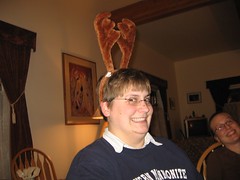Speaker: Elizabeth Lane Lawley, Rochester Institute of Technology
Libraries are an emotional center of a community that make people happy. The elements of happiness include: satisfying work to do, the experience of being good at something, time spent with people we like, and a chance to be a part of something bigger. Libraries will survive if we remain in the happiness business.
Virtuality is a way of beating an unhappy life. People go into virtual world to escape a lack of happiness in their real life. And, there is a blurring of the boundaries between virtual worlds and real worlds as players make connections in both that bleed over into the other.
“The grind” is a process that gamers go through in order to move forward or advance in levels. Players do tasks in game repeatedly until their goals are achieved. Lawley thinks of the grind as being a meditative activity, due in part to the repetitive nature of it. Why can’t we convey this to our potential readers? We can correlate the reward of working through a game to the reward of reading a book through to the end.
Tupperware parties are an example of real world games, with competition and rewards. Salespeople will work hard to move up levels and be recognized for their work. Another real world game that is popular in public libraries is Super Sleuth, which gives daily clues that kids research to find the answer every week. Summer reading programs are also like games, and they make reading a challenge that kids want to do in order to reach a point goal to win a prize.
Chore Wars is an online game that blurs the line between real and virtual worlds. Parents post job tasks with point values, and kids earn those points by doing the chores. In the business world, Seriosity’s Attent is a game that causes players to evaluate the value of email message sent and received. Social Genius takes casual game concepts and applies them to enterprise problems/solutions, basically by making players learn the names and faces of other people in their organization and forcing them to keep their online photos and bios up-to-date.
Passively Multiplayer Online Gaming gives points to players for visiting websites, among other things. Missions become annotated pathfinders that reward players for surfing websites that have some sort of relevancy to each other. It makes the process of going to websites fun instead of tedious.
Games can serve as gateway drugs, like Guitar Hero. [side note: I heard recently about someone modifying a real guitar to use the strum bar and buttons used on the Guitar Hero guitar.]
Online rebound is what happens when we go from virtual to real and back again, like LAN parties, Moo cards (“We love the web, but you can’t put it in your pocket.”), and Etsy (hand-crafted items sold online). Virtual does not take the tangible away. You want to retain a connection to the real world. Libraries are taking advantage of this online rebound by creating spaces where people can be together physically while also being online.
How does your library make people feel happy? How does it pull them into something bigger than themselves that makes them feel playful and productive at the same time?


